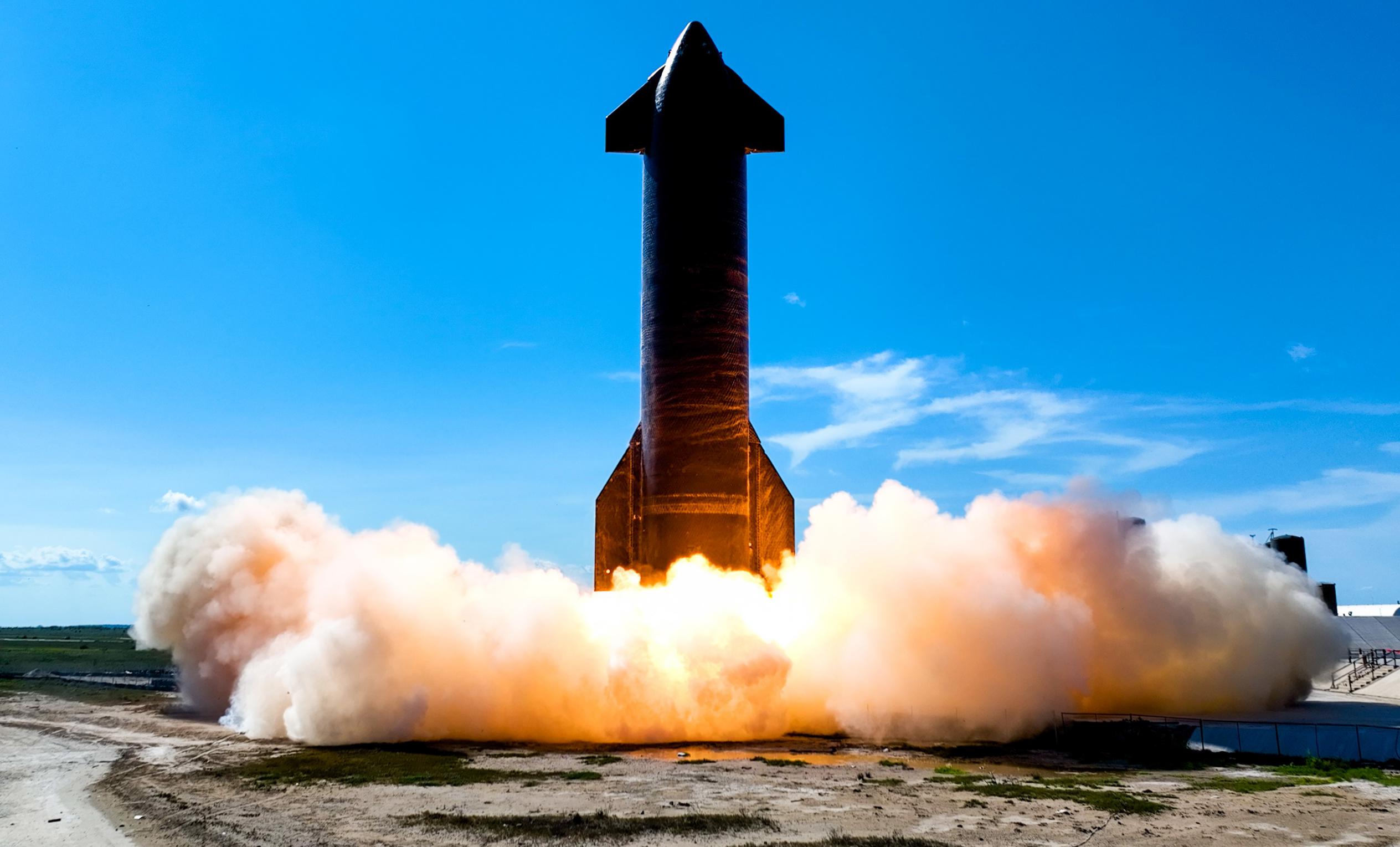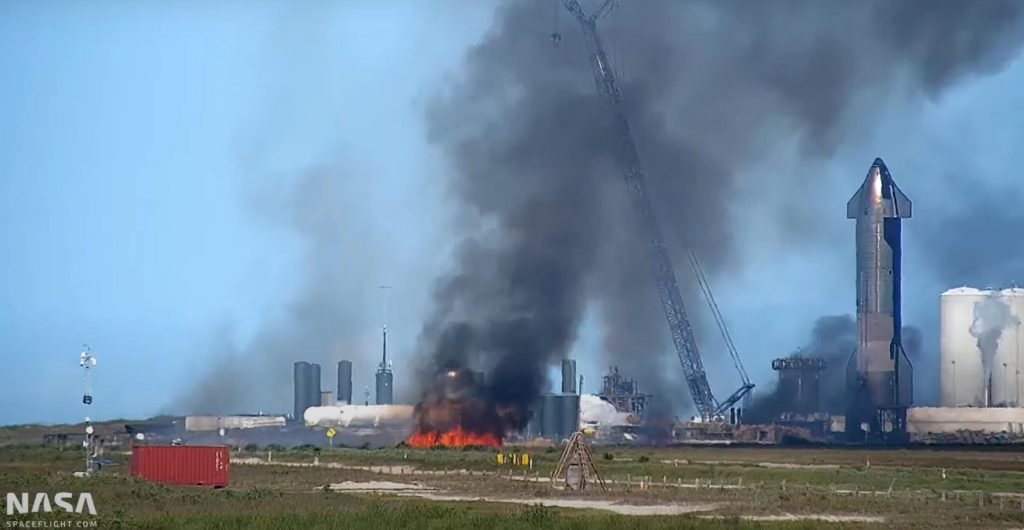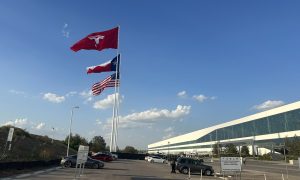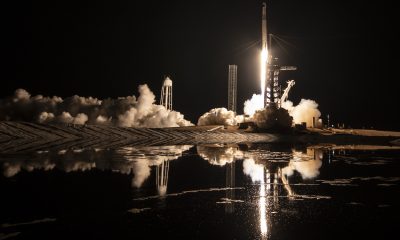

News
SpaceX Starship prototype ignites six engines, starts major brush fire
SpaceX has successfully ignited all six engines on its latest Starship prototype, taking a significant step towards ensuring that the upper stage will be ready for the rocket’s first orbital launch attempt.
Unfortunately, the same successful static fire of a Starship upper stage – potentially producing almost twice as much thrust as the booster of SpaceX’s Falcon 9 rocket – scattered superheated debris hundreds of meters away, igniting a major brush fire. It’s not the first major fire caused by Starship activities in South Texas, and it likely won’t be the last.
Starship S24 completed its first successful static fire on August 9th, igniting two Raptor engines. Several unsuccessful attempts to test more engines followed throughout the rest of the month, and SpaceX ultimately decided to replace one of Starship S24’s three Raptor Vacuum engines in early September before trying again. After workers installed the new engine and buttoned up Ship 24, the stars eventually aligned on September 8th.
Kicking off the test, SpaceX pumped several hundred tons of liquid oxygen (LOx) and a much smaller quantity of liquid methane (LCH4) fuel into Ship 24 in about 90 minutes, producing a crisp layer of frost wherever the cryogenic liquids touched the skin of the rocket’s uninsulated steel tanks. No frost formed on Starship’s upper methane tank, implying that SpaceX only loaded methane fuel into internal ‘header’ tanks meant to store propellant for landings. The hundreds of tons of liquid oxygen, then, were likely meant as ballast, reducing the maximum stress Starship could exert on the test stand holding it to the ground.
That potential stress is substantial. Outfitted with upgraded Raptor 2 engines, Starship S24 could have produced up to 1380 tons (~3M lbf) thrust when it ignited all six for the first time at 4:30 pm CDT. On top of smashing the record for most thrust produced during a Starbase rocket test, Ship 24’s engines burned for almost 8 seconds, making it one of the longest static fires ever performed on a Starship test stand.
Several brush fires were visible almost immediately after clouds of dust and steam cleared. More likely than not, the combination of the extreme force, heat, and burn duration likely obliterated the almost entirely unprotected concrete surface below Ship 24. Despite continuous evidence that all Starship static fire operations would be easier and safer with the systems, SpaceX still refuses to install serious water deluge or flame deflector systems at Starbase’s test stands and launch pads.
Instead, under its steel Starship test stands, SpaceX relies on a single middling deluge spray nozzle and high-temperature concrete (likely martyte) that probably wouldn’t pass muster for a rocket ten times less powerful than Starship. In multiple instances, Starships have shattered that feeble martyte layer, creating high-velocity ceramic shards that damage their undersides or Raptor engines, requiring repairs and creating risky situations. With essentially no attempt at all to tame the high-speed several-thousand-degree Raptor exhaust, static fire tests at Starbase thus almost always start small grass fires and cause minor damage, but those fires rarely spread.

Ship 24’s first six-engine test was not so lucky, although the Starship made it through seemingly unscathed. Most likely, eight long seconds of blast-furnace conditions melted the top layer of surrounding concrete and shot a hailstorm of tiny superheated globules in almost every direction. Indeed, in almost every direction there was something readily able to burn, a fire started. In several locations to the south and west, brush caught fire and began to burn unusually aggressively, quickly growing into walls of flames that sped across the terrain. To the east, debris even made it into a SpaceX dumpster, the contents of which easily caught fire and burned for hours.
Eventually, around 9pm CDT, firefighters were able to approach the safed launch pad and rocket, but the main fire had already spread south, out of reach. Instead, they started controlled burns near SpaceX’s roadblock, hoping to clear brush and prevent the fire (however unlikely) from proceeding towards SpaceX’s Starbase factory and Boca Chica Village homes and residents.
The nature of the estuary-like terrain and wetlands means that it’s very easy to stop fires at choke points, so the fire likely never posed any real threat to Boca Chica residents, SpaceX employees, or onlookers. It was also unlikely to damage SpaceX’s launch facilities or return to damage Starship S24 from the start, as both of are surrounded by a combination of concrete aprons, empty dirt fields, and a highway.
Still, the “brush” burned by the fire is a protected habitat located in a State Park and Wildlife Refuge. While fire is a natural and often necessary element of many habitats, including some of those in Boca Chica, this is the second major brush fire caused by Starship testing since 2019, which may be less than desirable. At a minimum, fighting fires around Starbase generally requires firefighters to walk or even drive on protected wetlands and salt flats, the impact of which could ultimately be as bad for wildlife and habitats as the fire itself.
SpaceX’s Federal Aviation Administration (FAA) Programmatic Environmental Assessment (PEA), which fully greenlit the company’s existing Starbase Texas facilities and launch plans earlier this year, only discusses fire [PDF] a handful of times. Repairing and preventing future damage to wetlands, however, comes up dozens of times and is the subject of numerous conditions SpaceX must meet before the FAA will grant Starship an orbital launch license.
Ultimately, given that the FAA approved that PEA in full awareness of a 2019 brush fire caused by Starhopper (an early Starship prototype) that may have been as bad or worse than 2022’s, there’s a chance that it will play a small role in the ongoing launch licensing process, but the odds of it being a showstopper are close to zero. Still, it would likely benefit SpaceX at least as much as the surrounding Boca Chica wilderness if it can implement changes that prevent major brush fires from becoming a regular ‘accidental’ occurrence.
News
Tesla begins Robotaxi certification push in Arizona: report
Tesla seems serious about expanding its Robotaxi service to several states in the coming months.

Tesla has initiated discussions with Arizona transportation regulators to certify its driverless Robotaxi service in the state, as per a recent report from Bloomberg News. The move follows Tesla’s launch of its Robotaxi pilot program in Austin, Texas, as well as CEO Elon Musk’s recent comments about the service’s expansion in the Bay Area.
The Arizona Department of Transportation confirmed to Bloomberg that Tesla has reached out to begin the certification process for autonomous ride-sharing operations in the state. While details remain limited, the outreach suggests that Tesla is serious about expanding its driverless Robotaxi service to several territories in the coming months.
The Arizona development comes as Tesla prepares to expand its service area in Austin this weekend, as per CEO Elon Musk in a post on X. Musk also stated that Tesla is targeting the San Francisco Bay Area as its next major market, with a potential launch “in a month or two,” pending regulatory approvals.
Tesla first launched its autonomous ride-hailing program on June 22 in Austin with a small fleet of Model Y vehicles, accompanied by a Tesla employee in the passenger seat to monitor safety. While still classified as a test, Musk has said the program will expand to about 1,000 vehicles in the coming months. Tesla will later upgrade its Robotaxi fleet with the Cyercab, a two-seater that is designed without a steering wheel.
Sightings of Cybercab castings around the Giga Texas complex suggests that Tesla may be ramping the initial trial production of the self-driving two-seater. Tesla, for its part, has noted in the past that volume production of the Cybercab is expected to start sometime next year.
In California, Tesla has already applied for a transportation charter-party carrier permit from the state’s Public Utilities Commission. The company is reportedly taking a phased approach to operating in California, with the Robotaxi service starting with pre-arranged rides for employees in vehicles with safety drivers.
News
Tesla sets November 6 date for 2025 Annual Shareholder Meeting
The automaker announced the date on Thursday in a Form 8-K.

Tesla has scheduled its 2025 annual shareholder meeting for November 6, addressing investor concerns that the company was nearing a legal deadline to hold the event.
The automaker announced the date on Thursday in a Form 8-K submitted to the United States Securities and Exchange Commission (SEC). The company also listed a new proposal submission deadline of July 31 for items to be included in the proxy statement.
Tesla’s announcement followed calls from a group of 27 shareholders, including the leaders of large public pension funds, which urged Tesla’s board to formally set the meeting date, as noted in a report from The Wall Street Journal.
The group noted that under Texas law, where Tesla is now incorporated, companies must hold annual meetings within 13 months of the last one if requested by shareholders. Tesla’s previous annual shareholder meeting was held on June 13, 2024, which placed the July 13 deadline in focus.
Tesla originally stated in its 2024 annual report that it would file its proxy statement by the end of April. However, an amended filing on April 30 indicated that the Board of Directors had not yet finalized a meeting date, at least at the time.
The April filing also confirmed that Tesla’s board had formed a special committee to evaluate certain matters related to CEO Elon Musk’s compensation plan. Musk’s CEO performance award remains at the center of a lengthy legal dispute in Delaware, Tesla’s former state of incorporation.
Due to the aftermath of Musk’s legal dispute about his compensation plan in Delaware, he has not been paid for his work at Tesla for several years. Musk, for his part, has noted that he is more concerned about his voting stake in Tesla than his actual salary.
At last year’s annual meeting, TSLA shareholders voted to reapprove Elon Musk’s compensation plan and ratified Tesla’s decision to relocate its legal domicile from Delaware to Texas.
Elon Musk
Grok coming to Tesla vehicles next week “at the latest:” Elon Musk
Grok’s rollout to Tesla vehicles is expected to begin next week at the latest.

Elon Musk announced on Thursday that Grok, the large language model developed by his startup xAI, will soon be available in Tesla vehicles. Grok’s rollout to Tesla vehicles is expected to begin next week at the latest, further deepening the ties between the two Elon Musk-led companies.
Tesla–xAI synergy
Musk confirmed the news on X shortly after livestreaming the release of Grok 4, xAI’s latest large language model. “Grok is coming to Tesla vehicles very soon. Next week at the latest,” Musk wrote in a post on social media platform X.
During the livestream, Musk and several members of the xAI team highlighted several upgrades to Grok 4’s voice capabilities and performance metrics, positioning the LLM as competitive with top-tier models from OpenAI and Google.
The in-vehicle integration of Grok marks a new chapter in Tesla’s AI development. While Tesla has long relied on in-house systems for autonomous driving and energy optimization, Grok’s integration would introduce conversational AI directly into its vehicles’ user experience. This integration could potentially improve customer interaction inside Tesla vehicles.
xAI and Tesla’s collaborative footprint
Grok’s upcoming rollout to Tesla vehicles adds to a growing business relationship between Tesla and xAI. Earlier this year, Tesla disclosed that it generated $198.3 million in revenue from commercial, consulting, and support agreements with xAI, as noted in a report from Bloomberg News. A large portion of that amount, however, came from the sale of Megapack energy storage systems to the artificial intelligence startup.
In July 2023, Musk polled X users about whether Tesla should invest $5 billion in xAI. While no formal investment has been made so far, 68% of poll participants voted yes, and Musk has since stated that the idea would be discussed with Tesla’s board.
-

 Elon Musk1 week ago
Elon Musk1 week agoTesla investors will be shocked by Jim Cramer’s latest assessment
-

 Elon Musk3 days ago
Elon Musk3 days agoElon Musk confirms Grok 4 launch on July 9 with livestream event
-

 Elon Musk14 hours ago
Elon Musk14 hours agoxAI launches Grok 4 with new $300/month SuperGrok Heavy subscription
-

 News7 days ago
News7 days agoTesla Model 3 ranks as the safest new car in Europe for 2025, per Euro NCAP tests
-

 Elon Musk2 weeks ago
Elon Musk2 weeks agoA Tesla just delivered itself to a customer autonomously, Elon Musk confirms
-

 Elon Musk1 week ago
Elon Musk1 week agoxAI’s Memphis data center receives air permit despite community criticism
-

 Elon Musk2 weeks ago
Elon Musk2 weeks agoTesla’s Omead Afshar, known as Elon Musk’s right-hand man, leaves company: reports
-

 News2 weeks ago
News2 weeks agoXiaomi CEO congratulates Tesla on first FSD delivery: “We have to continue learning!”



















